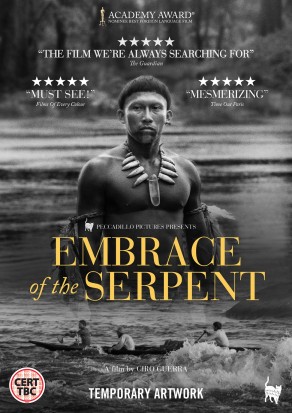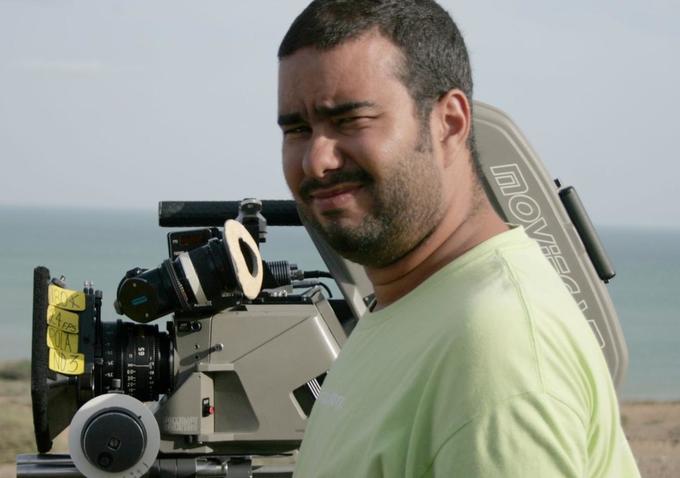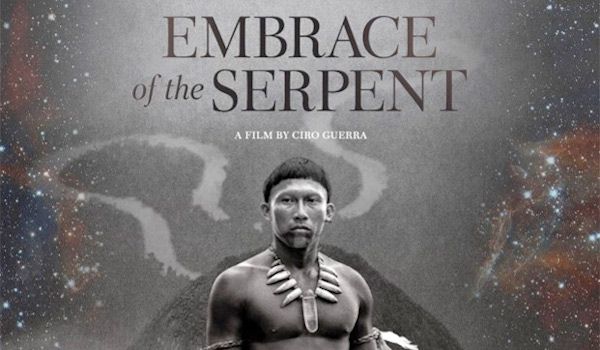CIRO GUERRA
“The films I make come from an intuitive and really honest place.”
The extraordinary existential period drama EMBRACE OF THE SERPENT takes the audience on a rural journey into evolution and perception as two generations of explorers encounter the same Amazonian shaman, Karamakata (played by a real-life inhabitant of the jungle area).
Shot in stunning black and white, director Ciro Guerra has evolved as a film-maker with this achievement, which has already won several international film awards and has cemented his reputation as a South American auteur.
Film and TV Now, along with several other journalists, were invited to be part of a special round-table Q & A at London’s Hospital Club to meet the film-maker and to gain some insight into how the film was made. The following questions are covered by several interviewers and the transcript reflects these questions and answers as best we can.
Q: This is my first experience with EMBRACE OF THE SERPENT. What is your experience of Colombia?
CIRO GUERRA: In every way, Colombia is very inspiring. Many stories are not told and people are watching the same stories of 30 years ago. It has new stories that have never been told.
Q: Is there a sense of myth-making?
GUERRA: For reasons I don’t understand, I like the mythical, something unreal.
Q: As somebody who is fascinated by indigenous tribes and the region itself, how did you research the film?
GUERRA: I read the diaries of the explorers and discovered a lot of it was new to me. Then after I finished reading I visited the Amazon and discovered that the Amazon described in the diaries no long exists.
As I went deeper the echoes of the story became more valid. The film is infused with Amazon myth and as such found a new narrative thread.
Q: You tell two stories in a way not dissimilar to THE GODFATHER PART II. What was the start-off point?
GUERRA: There was an earlier traveller called Shamberg about 60 years before the first of the two travellers in the film. The idea of a single spirit running through different men was part of the story shift.
Q: Why do you think the element of survival is important?
GUERRA: The script is based on real events and was an incredible experience. In the case of shamans, it was important to keep knowledge and what happens when that knowledge is shared with the world.
Interestingly, the Beat generation writers like Burroughs travelled to the Amazon and the first ecological moments were shared in this. It was great material to base a character. Whenever I see a contradiction it is always a good way to write.
Q: I was fascinated by the presence of sacred healing plants. How crucial were they to the story?
GUERRA: The plant in the film is not real. We had to fictionalise them for the sake of secrecy, but everything behind that is true.
Q: Is the plant inspired by certain medicinal plants?
GUERRA: Yes, the plant is used for the purpose of historical means. The knowledge is how to mix plants, as individually they don’t work.
Q: One scene that comes to mind is when the tribesmen refuse to give back a compass. Is this a message about the sharing of knowledge?
GUERRA: In part, but that is also to present a moral dilemma, one the audience has to question also. The idea of private property is something that makes tribesmen laugh.
Q: Did you face challenges whilst shooting?
GUERRA: It was difficult to find a region that hadn’t been affected. We eventually found a remote area that wasn’t. 70% of the film was in a camp made with the permission of indigenous tribes. The crew was very open and not determined to have a negative effect on the region.
Q: You used real-life tribesmen. What was it like for them experiencing movie-making which could be seen as an unknown technology?
GUERRA: Well, we used some tribesmen who were cultured and had experience of cell phones for example. It would not have been wise to use isolated tribes.
Q: There are certain common behaviours in your films. What’s the key?
GUERRA: The films I make come from an intuitive and really honest place, something profound and allowing it to go out. Somebody who looks at my films with care notes things aboutme I don’t even know myself. It’s not something I calculate.
Q: I wanted to ask about the symbolism of the jaguar eating the python. Does this represent triumph over evil?
GUERRA: The audience will always complete the film and make it richer.
Q: Religion plays a part in both parallel stories in the film. What’s the significance?
GUERRA: Although I was brought up a Catholic, I am spiritual but not religious. I am fascinated by the contradictions of Catholicism. In the journals the characters portrayed in the film were a lot crazier.
Q: Finally, what is coming up?
GUERRA. I have a sci-fi story from a book called Peter Lilley – a story about Capitalism. I am fascinated by the concept. Before that, my next project is, provided I can get it going, an adaptation of BIRDS OF PASSAGE, to be shot in the North of Colombia.































